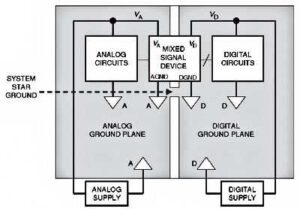How to Relayout Circuit Board Digital and Analog Ground to make the Printed circuit board has a better performance after manufacturing, first step is to reverse engineering printed circuit board and extract original layout drawing and netlist from it;
Before redesigning pcb board layout for a better emc performance, you must understand the two basic principles of electromagnetic compatibility (EMC): the first principle is to reduce the area of the current loop as much as possible; the second principle is that the system uses only one reference plane. Conversely, if there are two reference planes in the system, a dipole antenna may be formed (Note: the radiation size of a small dipole antenna is proportional to the length of the line, the amount of current flowing, and the frequency);

Relayout Circuit Board Digital and Analog Ground to make the Printed circuit board has a better performance after manufacturing
If the signal can’t be returned through the smallest possible loop, a large loop antenna may be formed (Note: The radiation size of a small loop antenna is proportional to the loop area, the amount of current flowing through the loop, and the square of the frequency). Avoid these two situations as much as possible in the design.
It was suggested that the digital and analog grounds on the mixed-signal circuit board must be reverse engineering be separated to achieve isolation between the digital and analog grounds. Although this method is feasible, there are many potential problems, especially in complex large-scale systems.
The most critical issue is that the wiring cannot be crossed across the division gap. Once the wiring across the division gap is crossed, the electromagnetic radiation and signal crosstalk will increase dramatically. The most common problem in PCB design is that the signal line crosses the split ground or the power supply and generates EMI.






